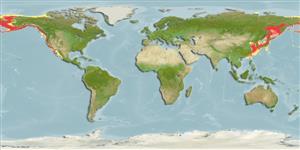Common names from other countries
Classification / Names / Names
俗名 | 同种异名 | Catalog of Fishes (gen., sp.) | ITIS | CoL | WoRMS
Environment: milieu / climate zone / depth range / distribution range
生态学
大洋性; 海洋洄游的 (Ref. 75906); 深度上下限 1 - 2500 m, usually 30 - 500 m. ; 90°N - 0°S, 115°E - 105°W
Pacific Ocean, Atlantic Ocean and the Arctic: Extinct in North Atlantic; two populations in North Pacific. Tropical to polar. [western population: IUCN 2010 (Ref. 84930): CR, C2a(ii);E.]
Length at first maturity / 大小 / 重量 / 年龄
Maturity: Lm 1,220.0 range ? - ? cm Max length : 1,500 cm TL 雄鱼/尚未辨别雌雄; (Ref. 1394); 最大体重: 35.0 t (Ref. 1394); 最大年龄: 48 年 (Ref. 128170)
Lives within a few tens of kilometers of shore. Bottom feeders that feed primarily on swarming mysids and tube-dwelling amphipods in the northern parts of their range, but are also known to take red crabs, baitfish, and other food opportunistically. The North Atlantic stock was apparently wiped-out by whalers in the 18th century. A western North Pacific (Korean) stock may also have been extirpated in the mid 20th century; its continued existence as a small remnant is still debated. The eastern North Pacific (California-Chukotka) stock nearly suffered the same fate twice, once in the late 1800s and again in the early 1900s. Both times, a respite in commercial whaling allowed the population to recover. About 170 to 200 from this latter stock are killed annually under special permit by commercial whalers on behalf of Soviet aborigines, and one or a few are taken in some years by Alaskan Eskimos. Since receiving IWC protection in 1946 and the end of research harvests in the late 1960s this population has increased, and now apparently equals or exceeds pre-exploitation numbers (Ref. 1394). Lives within a few tens of kilometers of shore. Bottom feeders that feed primarily on swarming mysids and tube-dwelling amphipods in the northern parts of their range, but are also known to take red crabs, baitfish, and other food opportunistically (Ref. 1394).
主要参考文献
参考文献 | 合作者 | 合作者
Jefferson, T.A., S. Leatherwood and M.A. Webber. 1993. (Ref. 1394)
世界自然保护联盟红皮书 (Ref. 130435)
Not Evaluated
人类利用
渔业: 商业性
FAO - 渔业: landings, 物种外形 | FishSource | 周边海洋
工具
网络资源
Estimates based on models
Preferred temperature
(Ref.
115969): 0.4 - 17.3, mean 3.5 (based on 1706 cells).
回复力
中等的, 族群倍增时间最少 1.4 - 4.4年 (K=0.19-0.25; tm=8; tmax=48).
脆弱性
High vulnerability (56 of 100).
价格分类
Unknown.
